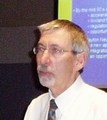FLASHBACK TO 2008: “There is no piped drainage system on the site. Water stored on the roof spills onto a dry creek bed and flows sub-surface to a marsh,” stated the City of Nanaimo’s Dean Mousseau when he described the ‘design with nature’ approach to rainwater management at the Inland Kenworth site (YouTube Video)

The Inland Kenworth truck and heavy equipment facility in the City of Nanaimo illustrates what can be accomplished through collaboration when a municipality challenges a development proponent to be innovative, green the built environment, and protect stream health. “We view this project as the one that changed the thinking of the consulting community in Nanaimo, particularly on redevelopment projects. We are turning the tide because projects are now incorporating features for rainwater runoff capture,” stated Dean Mousseau.










